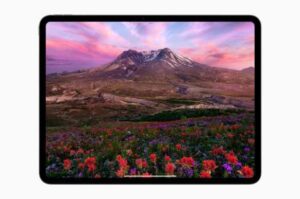Apple introduced the new iPad Pro and its Tandem OLED display. The technology, which Apple calls “Ultra Retina XDR,” creates a new display that will soon be seen in more of the company’s devices. So what is this Tandem OLED, the technology behind the Ultra Retina XDR display? Here is a short explanation.
What is Tandem OLED and how it differs from regular OLED displays
Tandem OLED is a unique display technology that includes two layers of OLED pixels layered on top of each other to create one consistent screen. By combining light from both panels, iPad Pro can achieve an impressive full-screen brightness of 1,000 nits for both SDR and HDR content, with maximum HDR brightness reaching 1,600 nits.

In contrast, regular OLED displays typically have lower brightness levels, as increasing brightness can lead to potential burn-in issues and reduced display lifespan. The Tandem OLED structure addresses these challenges by spreading the load across two panels, resulting in higher brightness and better performance.
What are the advantages of Tandem OLED
There are many benefits of Tandem OLED. Above all, unmatched brightness levels of 1,000 nits for full-screen content and 1,600 nits for premium HDR content deliver a stunning viewing experience that outperforms other mobile devices. This makes iPad Pro ideal for use in a variety of lighting conditions, from dimly lit indoors to bright outdoor environments.
Precise control over each pixel enables the display to reproduce colors with exceptional accuracy, making it ideal for professional content creation and consumption.
Finally, submillisecond control over pixel color and luminance provides a more responsive and smooth display, improving the user experience while gaming and video playback.
What problems does Tandem OLED fix?
There are two main issues with OLED screens, whether that’s on the OLED TVs, laptops or smartphones.
The first is brightness. OLED screens are not especially bright compared to what you can do with LED/LCD screens. And this is a problem with any device that will be used in sunlight or any bright environment, because it means you’ll face reflections that interfere with what you’re seeing.
The second is ‘burn-in’. OLED screens are prone to an problem where images that stay on an OLED screen for a very long time, such as the Taskbar in Windows, or the floating ‘Home’ bar on iPadOS, may become imprinted on the display permanently, leaving a ghost image that’s always there, even when you have something else displayed.
These two problems are somewhat connected: you could make OLED screens brighter by pushing more power through them, but that generates a lot more heat, and heat is a big factor in causing burn-in.
Tandem OLED screens, like the new iPad Pro’s, are supposed to solve both of these issues by, essentially, throwing pixels at the problem.
With two layers of OLED pixels, there is literally twice as much light being produced, because OLED pixels generate their own light. This allows Apple to reach 1,600 nits of peak HDR brightness and 1,000 nits of fullscreen HDR brightness, which is exactly what the previous iPad Pro could achieve using a mini-LED screen. This is way beyond what other large OLED screens manage, especially for the fullscreen brightness. For comparison, the brightest fullscreen OLED TV measurement we’ve ever taken is 318 nits, during our Samsung S95D review. Apple is delivering triple that – albeit, in a much smaller screen.
That solves the brightness issue, but what about burn-in? Well, the other advantage of using two layers of pixels is that if you’re using the device at a more standard brightness (as you will be the vast majority of the time), each layer can run less bright than a single layer would have to, making each more efficient in terms of energy and heat use. That helps to reduce a key cause of burn-in, and should help to keep the screen going for longer in general.
At least, these are the goals of Tandem OLED as a technology. And all while keeping the things that OLED is renowned for, including excellent image quality from all viewing angle, superb color reproduction and – of course – unmatched per-pixel contrast and realistic black tones.

